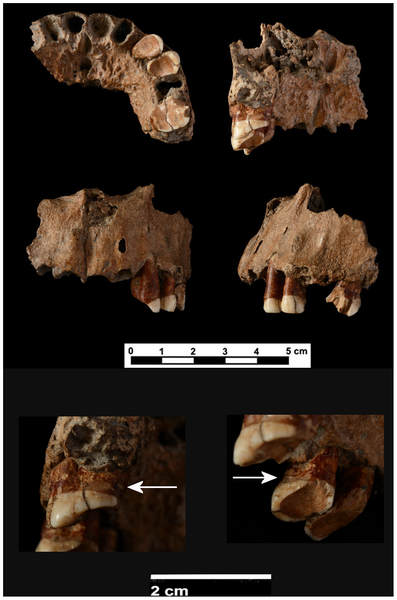

| Visitors Now: | |
| Total Visits: | |
| Total Stories: |

| Story Views | |
| Now: | |
| Last Hour: | |
| Last 24 Hours: | |
| Total: | |
Tooth Picks Invented Nearly Two Million Years Ago
In the left image, the arrow shows the interproximal groove of the upper Pm3. The right image is a groove detail view as seen with an Environmental Chamber Electron Microscope.
Credit:PLoS ONE
The chronology of the fossil is not clear, but the fossil remains were associated with a Neanderthal Mousterian lithic industry (about 150,000 to 50,000 years).
The research showed that the remains had maxillary porosity, characteristic of periodontal disease and alveolar bone loss (where the teeth are inserted), with a bone mass reduction of four to eight millimeters exposing the roots of the teeth, usually inside the alveoli.
Detailed images of the last row: lower left, the arrow shows the interproximal groove on distal surface of left M1. Lower right, the arrow shows the interproximal groove on distal surface of left Pm3.

Credit: doi:10.1371/journal.pone.0076852.g002
The examples of grooves caused by toothpicking are numerous between Neanderthals and usually are not associated with any dental disease. “However, in the case of Cova Foradà the toothpick was not only used as a primitive method of dental hygiene, but it is associated with a dental disease and with the clear intention to alleviate the pain, and that makes it unique”, said Marina Lozano.
This means that we have one of the first examples of palliative treatment with toothpicks, the oldest documented. Therefore, “this study is a step to characterize the Neanderthals as a species with a wide range of adaptations to their environment and wide resources even in the field of palliative medicine” says the same researcher.
Universitat Autònoma de Barcelona
Citation: “Toothpicking and periodontal disease in a Neanderthal specimen from site Cova Foradà(Valencia, Spain)”, published by PLOS ONE, in its issue of October 16. It has been written by Marina Lozano, Carlos Lorenzo and Gala Gomez of the IPHES (Institut Català de Paleoecologia Humana I Evolució Social), in collaboration with Maria Eulalia Subirà, Biological Anthropology professor and researcher at the Universitat Autònoma de Barcelona (UAB), and José Aparicio of the Diputació Provincial de València


